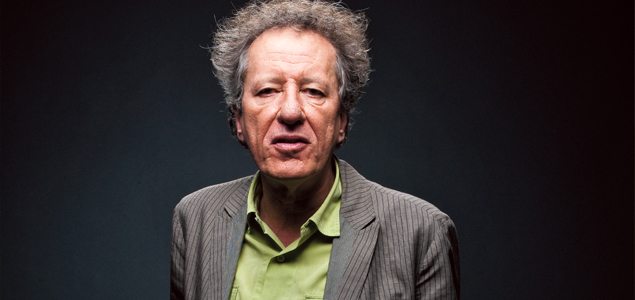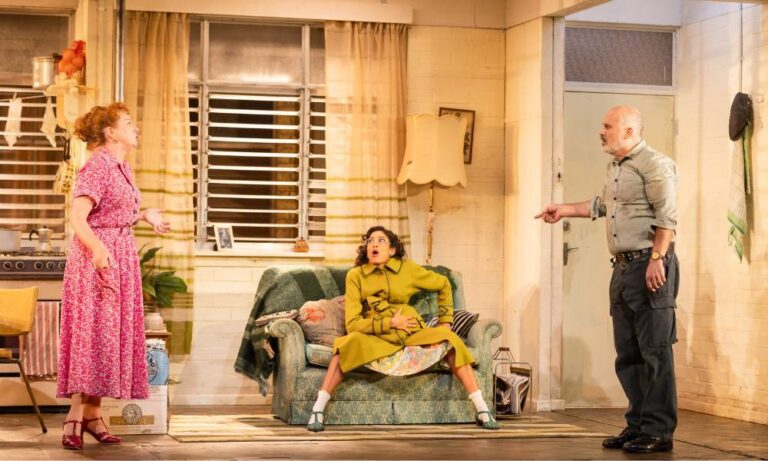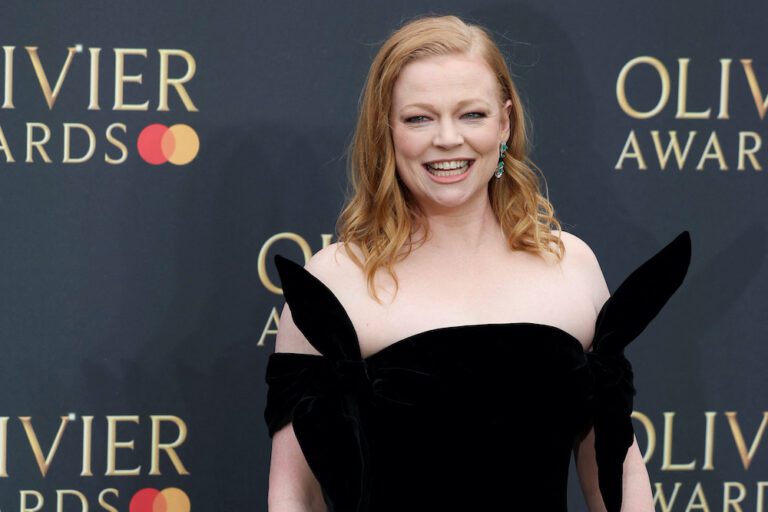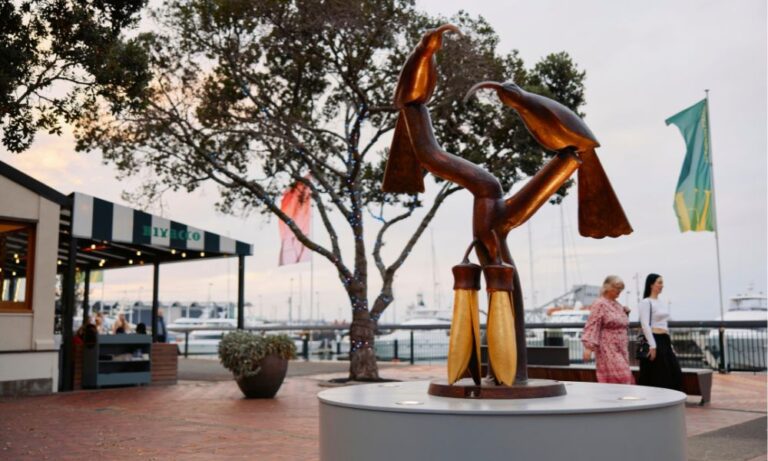Geoffrey Rush was named Australian of the Year in 2012 for his contribution to the arts. He is one of few people who have won the “Triple Crown of Acting” – an Academy Award, a Tony Award and an Emmy Award.
At the Arts Centre in Melbourne, until the end of October, is an exhibition called The Extraordinary Shapes of Geoffrey Rush, which celebrates the actor’s many achievements to date and explores his ability to inhabit characters through a remarkable physical and verbal deftness.
Showcasing costumes, photographs, moving images and personal items, it highlights roles created by Rush in plays including Exit the King and The Diary of a Madman and in films such as Shine, Pirates of the Caribbean and The King’s Speech.
“I could almost put in ‘curator’ now on my immigration card or tax form mainly because a lot of it was in my head,” he says.
The Arts Centre started talking about the exhibition well over a year ago while Rush was shooting The Book Thief in Berlin. “I had left it all with them. By then, we had already determined the theme and the sort of things we’d like to have in it because I wanted it to be not too much of a eulogy or not too much of a museum piece … more like a sideshow.” But Rush is hardly a sideshow.
The Big Break
Starting his career in Australian theatre, Rush was catapulted to fame with his starring role in director Scott Hicks’ film Shine. By the time he was in his early to mid-40s, he thought, “Well, if I keep fit and I keep adventurous enough, hopefully I’m going to have an ongoing and substantial career working in the theatre.”
In the back of his mind when he started out, he thought it would be great when at the age of 70 he would still be putting “actor” on his immigration card or tax form. “The Australian film industry kind of rebooted itself around the time that I was starting out at the Queensland Theatre Company in the early 1970s. I got very excited by that because when I went to study in Paris in the mid-1970s, I started seeing all these extraordinary Australian films, like Picnic at Hanging Rock and Sunday Too Far Away and I went, ‘Wow, these are really amazing films’. And also, I felt a bit of homesickness because it was just amazing to hear Australian voices and see films about shearers because my stepdad was a shearer.”
Those films had an impact, although Rush was never envious of the actors because, as he saw it, “I just thought that’s not what I do, I’m heading down a more quasi-tactical theatrical path and I was content with that.”
Even with the second wind of Australian films such as Muriel’s Wedding, Strictly Ballroom and The Adventures of Priscilla, Queen of the Desert, he thought, “this is very exciting” but by then he was established doing plays like Uncle Vanya.
“I remember in the mid-1980s thinking I couldn’t see myself physically right for any movie part. I was still quite skinny in my 30s and I thought maybe I could try out for a prisoner-of-war role – it would be fun to go on a movie set. But then, when Shine came along, I played a lot of parts like the fool in King Lear, a lot of Shakespeare and there was something about that character that I thought, ‘I’m really drawn to this’.” In time Rush realised there were possible roles out there but you had to be very certain of “your own sense of dimension” as to what was right for you and what was your territory.
Shrewd Moves
“Sensibility and adaptability,” are the two things that Rush says he has discovered you have to have to always be on top.
After the extraordinary success of Shine, the first offer after that was Les Miserables.
“I thought this is actually the time to take a very bold and brave step because I had been offered a Liberace film from one of the Hollywood studios and they obviously pretty much like to pigeonhole people, and were probably looking for another keyboard vehicle, and that if I had done a western, I’d be looking for another western.” He turned that one down and thought “No, I didn’t want to be on the piano again.” Les Miserables didn’t have a wide release – “they should have platformed it and let it find its proper audience. Up against Deep Impact it didn’t have a chance.”
In a way it was a good calling card that led directly to Elizabeth and Shakespeare in Love. These days, Rush is involved more with the entire movie process. “Financially, it’s a very crazy needle on the barometer. Sometimes there are better pay days. Put it this way, something like Quills had a budget of US$13 million when Pirates probably had a budget of US$220 million. Not that I see much of that but it’s a different kind of scale of film that you’re working on.”
In his latest film The Best Offer, he plays the principal role central to the story written and directed by the acclaimed director of Cinema Paradiso, Giuseppe Tornatore. Rush plays a character by the name of Virgil Oldman, a solitary, cultured man who is reluctant to engage with others, except when it comes to his obsessiveness with his career as an art expert and auctioneer.
Rush is at his best playing this type of multi-layered character. “These roles don’t come along that often,” he says. “I think I’m in almost every scene of the film. There is a lot of calibration to determine particularly the subtle shifts that happen in a man who starts off comfortable in his lonely, isolated but extremely wealthy, aristocratic world.”
The character dines in gourmet restaurants, he dresses in the most impeccable clothing, he lives in complete luxury but has a deep unabiding loneliness. He dyes his hair.
“Part of the calibration is Giuseppe was shooting it all over the place. We shot in Vienna for a couple of weeks, then we were in Italy for about six weeks because it was a good substitute for the Austro-Hungarian architecture.”
Collaborative Approach
Tornatore visited Rush in Melbourne where they spent three or four intensive days microscopically going through all aspects of the story, as well as the alternative film to the one that people think they might be watching. “There had to be a kind of double game without giving away too many spoilers,” says Rush. “The best part of [Tornatore] being involved was taking breaks. I took him to various Italian restaurants and without fail in each and every one of them, there would always be a maître d’ or a waiter that would do a double-take and go ‘Maestro! Maestro Tornatore, what are you doing here?’ He’s a very revered and beloved figure in the Italian film world.”
It was not long after Tornatore was in Melbourne that there was a big scam about fairly high-end auction houses and galleries being involved in a series of fake Brett Whiteley paintings.
“Everyone reads about that with great interest because you’re talking millions of dollars. It’s like thievery or conspiracy on a very high level with large amounts of money and I think people get intrigued by the whole ethos,” says Rush. “I remembered the first time being staggered, it must have been 30 years ago, when they sold Van Gogh’s art for $38 million or something and I thought ‘My God, he wouldn’t have minded a small percentage of that when he was actually alive.’”
One of the names that was mentioned in the newspaper reports was a comment from an Australian auctioneer who was celebrated in Europe and London, so Rush Googled his name and found that he had an English and Melbourne work site.
“So, I rang the Melbourne number and said, ‘Look, I’m just interested in tracking down Roger McIlroy to get hold of him and set up a correspondence via email.’ And she said, ‘He’s sitting right next to me now.’ So he got on the phone and I explained the whole scenario and he came over. He was literally two or three suburbs away from where I lived in Melbourne.”
Hands-on Research
Rush and McIlroy went through the scripts as Rush wanted; “the real nuts and bolts, the authenticity and what really happens. He gave me some really great pointers, particularly about the idea [that] the personality behind the scenes might be quite different from what you see on the podium.
“On the podium, it’s a very ego-driven performance and also they might be required to get 300 items through the auction so every minute that they’re banging that gavel you could be dealing with up to seven or eight figures in terms of the amount of money so it’s a pretty high-octane, high-adrenaline event – a great sense of its own theatre.”
It’s fair to say Rush mastered the art of playing an auctioneer with a mix of humour and arrogance.
“Obviously if you’re going to play an art auctioneer it’s good to either see footage or go to auctions. At that stage, I didn’t actually have time to get to them but I had been to auctions in the past, not so much as a buyer but just interested in seeing stuff going to Sotheby’s or Christie’s or whatever. It’s an interesting balance of very curatorial precision and the jargon of when people describe things, the kind of lexicon of words and images that have become quite fantastical.”
Is Rush an art collector himself?
“No, not really. I live in a fairly artistic environment. My sister-in-law is a very good painter and etcher, my wife dabbles for her own enjoyment in painting and my daughter is now doing a design art course, so often the smell of turpentine is dominant around the house.”







